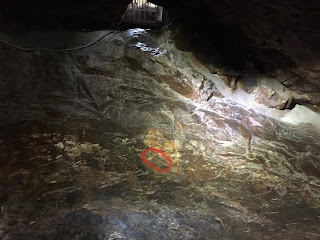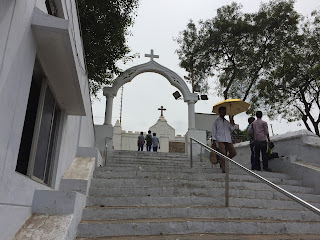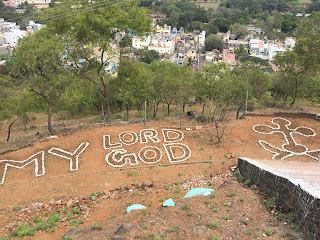Following on from my recent posts about St Thomas Mount and Little Mount, this one explores another key Thomas location, St Thomas Basilica in Mylapore, Chennai, India. This is the place where Thomas's tomb is allegedly located and an impressive neo-Gothic cathedral is on the site.
Once again, I recorded my thoughts and edited them in the latest episode of the NT Pod:
NT Pod 79: Santhome Basilica
The magnificent white church building was built by the British in the late nineteenth century but the basilica was built by the Portuguese in the 16th century (cf. the church at Little Mount). I decided to make the journey by bus, which is something of a challenge, not least because the buses in Chennai are so unbelievably crowded. But they are also unbelievably cheap. A one-way journey lasting an hour (over about 17 km) cost me just 12 rupees (about 12p or 18c).
There is one huge advantage that this site has over the previous two that I visited -- it has a museum dedicated to the Apostle Thomas. And the museum features several items of interest. Unlike St Thomas Mount, it is not just about John 20 and "My Lord and My God". There is much more by way of the apocryphal Thomas traditions, perhaps most interestingly this relic of the lancehead that supposedly killed Thomas.
There is also a double-sided pedestal that references King Gondophores and the legend of the log on the one side (a legend also illustrated in a relief that is on the wall of the museum), and Thomas in teaching mode on the other side.
Somewhat frustratingly, a lot of the other material in the museum is labelled only in the most vague way imaginable. So there is an entire display of ancient pottery apparently discovered at the site, with dating only to "the olden days"! So too another display of bones is said to be from that same period.
The museum itself is situated above Thomas's tomb. The tomb is at the front of a chapel with pews where people pray and reflect. There is not a lot to see -- it's a colourful, relatively modern representation of Thomas in glass casing.
Although in the podcast I say that I could not take a photograph in there, I later managed to return to the site when it was empty and I took a quick pic while no one was looking.
I should also mention the large golden "pole of St Thomas" which stands tall to the side of the cathedral. It is reminiscent of the similar poll at St Thomas' Mount, although this one is taller and has a much smaller cross at the top.
Inside the cathedral itself, I should mention a nice statue of Thomas that sits to the left of the altar. Thomas is holding the legend "Deus Meus" (My God), so here, for once, we do not get the whole Johannine confession. Again, we were not supposed to be taking photographs, but my visit happened to coincide with a coachload of pilgrims from Nagaland, all of whom were snapping away with gay abandon (and rather bizarrely, they also all wanted to get pictures with me! I sat with various members of the group outside the cathedral for a good ten or fifteen photos!).
I was a touch disappointed that the promised twenty minute film about Thomas, which is very proudly advertised just outside the museum, was nowhere in evidence. At least I found it impossible to find anyone who could tell me any more about it.
Another curiosity of my visit, and this is partly reflected in the podcast, is the pursuit (one might say harassment) by several auto rickshaw drivers. One of them followed me around the entire site, usually on foot, but sometimes in his auto. At first, he made out that he was connected with the site and I foolishly engaged him in conversation. But soon it became clear that he wanted my business.
Once I'd shaken him, I got another, who even sat next to me in the cathedral. Once rid of him, and after the photographing session with the people from Nagaland, a third one began to pursue me. This one was the worst, and pursued me down the road after I left the site, even driving ahead of me, hiding behind a tree and jumping out in front of me.
A fourth auto driver was honest enough to tell me why they were so keen for business -- a group of four local shops selling hand-crafted goods were offering a 5kg bag of rice to any auto driver who brought them a new customer. Much later in the day, after my Veg Maharaja Mac at McDonald's, I happened to meet this guy again at the beach, where I was heading in the direction of the bus-stop for my journey back, and I rewarded his honesty by going on the little shop-tour so that he could pick up his bag of rice. But of course no good deed goes unpunished. We parted on bad terms because I would not also pay his rent for the next month.
Once again, I recorded my thoughts and edited them in the latest episode of the NT Pod:
NT Pod 79: Santhome Basilica
The magnificent white church building was built by the British in the late nineteenth century but the basilica was built by the Portuguese in the 16th century (cf. the church at Little Mount). I decided to make the journey by bus, which is something of a challenge, not least because the buses in Chennai are so unbelievably crowded. But they are also unbelievably cheap. A one-way journey lasting an hour (over about 17 km) cost me just 12 rupees (about 12p or 18c).
There is one huge advantage that this site has over the previous two that I visited -- it has a museum dedicated to the Apostle Thomas. And the museum features several items of interest. Unlike St Thomas Mount, it is not just about John 20 and "My Lord and My God". There is much more by way of the apocryphal Thomas traditions, perhaps most interestingly this relic of the lancehead that supposedly killed Thomas.
There is also a double-sided pedestal that references King Gondophores and the legend of the log on the one side (a legend also illustrated in a relief that is on the wall of the museum), and Thomas in teaching mode on the other side.
Somewhat frustratingly, a lot of the other material in the museum is labelled only in the most vague way imaginable. So there is an entire display of ancient pottery apparently discovered at the site, with dating only to "the olden days"! So too another display of bones is said to be from that same period.
The museum itself is situated above Thomas's tomb. The tomb is at the front of a chapel with pews where people pray and reflect. There is not a lot to see -- it's a colourful, relatively modern representation of Thomas in glass casing.
Although in the podcast I say that I could not take a photograph in there, I later managed to return to the site when it was empty and I took a quick pic while no one was looking.
I should also mention the large golden "pole of St Thomas" which stands tall to the side of the cathedral. It is reminiscent of the similar poll at St Thomas' Mount, although this one is taller and has a much smaller cross at the top.
Inside the cathedral itself, I should mention a nice statue of Thomas that sits to the left of the altar. Thomas is holding the legend "Deus Meus" (My God), so here, for once, we do not get the whole Johannine confession. Again, we were not supposed to be taking photographs, but my visit happened to coincide with a coachload of pilgrims from Nagaland, all of whom were snapping away with gay abandon (and rather bizarrely, they also all wanted to get pictures with me! I sat with various members of the group outside the cathedral for a good ten or fifteen photos!).
I was a touch disappointed that the promised twenty minute film about Thomas, which is very proudly advertised just outside the museum, was nowhere in evidence. At least I found it impossible to find anyone who could tell me any more about it.
Another curiosity of my visit, and this is partly reflected in the podcast, is the pursuit (one might say harassment) by several auto rickshaw drivers. One of them followed me around the entire site, usually on foot, but sometimes in his auto. At first, he made out that he was connected with the site and I foolishly engaged him in conversation. But soon it became clear that he wanted my business.
Once I'd shaken him, I got another, who even sat next to me in the cathedral. Once rid of him, and after the photographing session with the people from Nagaland, a third one began to pursue me. This one was the worst, and pursued me down the road after I left the site, even driving ahead of me, hiding behind a tree and jumping out in front of me.
 |
| Gandhi, on the beach at Mylapore, Chennai |































